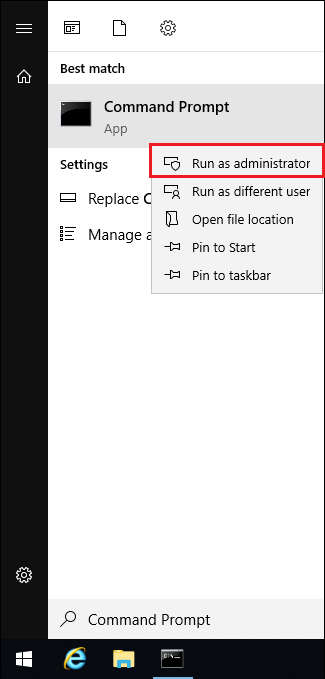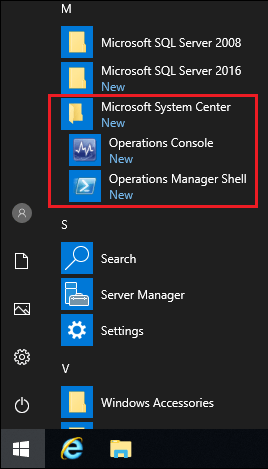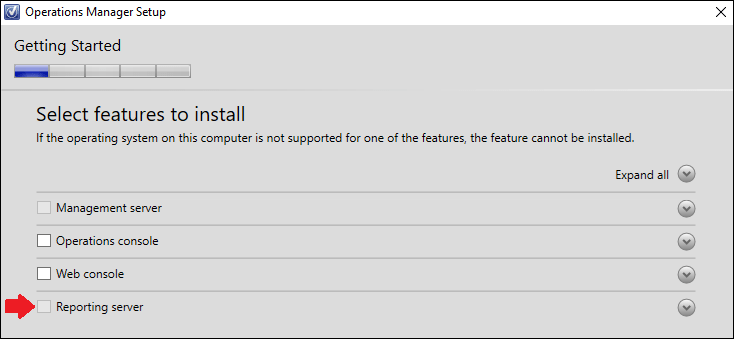Installing SCOM 2019 from the command-line
Applies to
This guide applies to System Center Operations Manager 2019
Introduction
Ever needed to automate installations of SCOM? In this blog post, we’ll go through on how to install SCOM 2019 by using only the command line.
Ever since SCOM 2007 R2 there has been the possibility to install SCOM from the command line, it’s not a new feature really, but many still don’t know about it’s existence or use it for that matter.
Performing unattended installations or simply installations from the command line can be very useful when wanting to automate processes/installations.
All SCOM features except the Audit Collection Services (ACS) can be installed from the command line, the official documentation for the command line reference can be found over here:
Installing Operations Manager from the Command Prompt
SCOM installation command line reference
| Parameter | Value |
| /Silent | Does not display the installation wizard. |
| /Install | Runs an installation. Use /Components to indicate specific features to install. |
| /InstallPath | Runs an installation specifying an alternative location, to change the default path for install to another drive. |
| /Components | OMserver: install a management server. OMConsole: install an Operations console. OMWebConsole: install a web console. OMReporting: install a Reporting server. |
| /ManagementGroupName: | The name of the management group. |
| /ManagementServicePort: | Change the Management Server port on install. |
| /SqlServerInstance: | The SQL server and instance <server\instance> or Always On availability group listener. |
| /SqlInstancePort: | The SQL server instance port number. |
| /DWSqlServerInstance: | The data warehouse server and instance <server\instance> or Always On availability group listener. |
| /DWDatabaseName: | The name of the data warehouse database. |
| /UseLocalSystemActionAccount | Used to specify the Local System for the Management server action account. |
| /ActionAccountUser: | The domain and user name of the Management server action account. Used if you do not want to specify the Local System. |
| /ActionAccountPassword: | The password for the Management server action account. Used if you do not want to specify the Local System |
| /UseLocalSystemDASAccount | Used to specify the Local System for the Data Access service account. |
| /DASAccountUser: | The domain and user name of the Data Access service account. Used if you do not want to specify the Local System. |
| /DASAccountPassword: | The password fo the Data Access service account. Used if you do not want to specify the Local System. |
| /DataReaderUser: | The domain and user name of the data reader account. |
| /DataReaderPassword: | The password for the data reader account. |
| /DataWriterUser: | The domain and user name of the data writer account. |
| /DataWriterPassword: | The password for the data writer account. |
| /EnableErrorReporting: | Never: Do not opt in to sending automatic error reports. Queued: Opt into sending error reports, but queue the reports for review before sending. Always: Opt in to automatically send error reports. |
| /SendCEIPReports: | 0 : Do not opt in to the Customer Experience Improvement Program (CEIP) 1 : Opt in to CEIP. |
| /UseMicrosoftUpdate: | 0 : Do not opt in to Microsoft Update. 1 : Opt in to Microsoft Update. |
| /AcceptEndUserLicenseAgreement: | 0 : Do not accept the End User License Agreement (EULA) 1 : Accept the End User License Agreement (EULA). When performing a clean installation of System Center Operations Manager, this switch is needed for all management servers. It is also needed for other scripted installations. |
| /ManagementServer | Used to specify the name of the management server associated with a web console and/or Reporting server that is not installed on a management server. |
| /WebSiteName: | The name of the website. For default web installation, specift "Default Web Site". Used for web console installations. |
| /WebConsoleUseSSL | Specify only if your website has Secure Sockets Layer (SSL) activated. User for web console installation. |
| /WebConsoleAuthorizationMode: | Mixed: Used for intranet scenarios. Network: Used for extranet scenarios. Used for web console installations. |
| /SRSInstance | The reporting server and instance <server\instance>. User for Reporting Server installations. |
| /SendODRReports: | 0 : Do not opt into sending operational data reports. 1. Opt into sending operational data reports. Used for Reporting Server installations. |
| /Uninstall | Uninstalls Operational Manager. Use /Components to indicate specific features to uninstall. If /Components is not specified, it will uninstall all features of Operations Manager on the server. |
The command line parameters can also be found over here: Command-line parameters
Installing SCOM 2019 from the command-line
Installing the Operations Manager Management server
Prerequisites:
Command-Line Reference:
**
**
setup.exe /silent /install /components:OMServer
/ManagementGroupName:"<ManagementGroupName>"
/SqlServerInstance:<server\instance or Always On availability group listener>
/SqlInstancePort:<SQL instance port number>
/DatabaseName:<OperationalDatabaseName>
/DwSqlServerInstance:<server\instance or Always On availability group listener>
/DwSqlInstancePort:<SQL instance port number>
/DwDatabaseName:<DWDatabaseName>
/UserLocalSystemActionAccount
/UseLocalSystemDASAccount
/DataReaderUser:<domain\username>
/DataReaderPassword:<password>
/DataWriterUser:<domain\username>
/DataWriterPassword:<password>
/EnableErrorReporting:[Never|Queued|Always]
/SendCEIPReports:[0|1]
/UseMicrosoftUpdate:[0|1]
/AcceptEndUserLicenseAgreement:1
Note: The above command assumes that you specified the Local System for the Management server action account (/UseLocalSystemActionAccount) and Data Access service (/UseLocalSystemDASAccount).
To specify a domain\user name for these accounts, you must provide the following parameters instead:
/ActionAccountUser:<domain\username> /ActionAccountPassword:<password>
/DASAccountUser:<domain\username> /DASAccountPassword:<password>
(Make sure that everything is one one line when you run the full command!)
**Note: **In the guide below, we will be using the ActionAccountUser and the DASAccountUser.
**1. **Open up a Command Prompt (Admin).
2. By default the Operations Manager Management Server will be installed in "C:\Program Files\":
If we want to install the Operations Console to another location, add the /InstallPath parameter:
setup.exe /silent /install /installpath:"D:\Program Files" /components:OMServer
3. Specify a management group name as follows:
/ManagementGroupName:"Management Group Name"
4. Provide the SQL Server instance for the SCOM database:
/SqlServerInstance:"server\instance" or "Always On availability group listener"
5. Provide the port of the SQL Server instance used by SCOM:
/SqlInstancePort:"SQL instance port number"
(If you use the default port, there’s no need to specify the /SQLInstancePort parameter)
6. Provide a database name for the Operational Database:
/DatabaseName:"OperationalDatabaseName"
7. Provide the SQL Server instance for the SCOM data warehouse:
/DwSqlServerInstance:"server\instance" or "Always On availability group listener"
8. Provide a database name for the Operational Data Warehouse:
/DwDatabaseName:"DWDatabaseName"
9. Provide a domain account and password for the Management server action service:
/ActionAccountUser: "domain\username"
/ActionAccountPassword:"password"
10. Provide a domain account and password for the System Center Configuration service and System Center Data Access service:
/DASAccountUser:"domain\username"
/DASAccountPassword:"password"
11. Provide a domain account and password for the Data Reader User:
/DataReaderUser:"domain\username"
/DataReaderPassword:"password"
12. Provide a domain account and password for the Data Writer User:
/DataWriterUser:"domain\username"
/DataWriterPassword:"password"
13. We will now need to add whether we want to enable error reporting or not, select one of the following values:
/EnableErrorReporting:Never
(Do not opt in to sending automatic error reports)
/EnableErrorReporting:Queued
(Opt into sending error reports, but queue the reports for review before sending)
/EnableErrorReporting:Always
(Opt in to automatically send error reports)
14. Next we will need to select whether we want to opt in the Customer Experience Improvement Program (CEIP) or not, select one of the following values:
/SendCEIPReports:0
(Do not opt in)
/SendCEIPReports:1
(Opt in)
15. Now we’ll need to choose if we want to opt in Microsoft updates or not, select one of the following values:
/UseMicrosoftUpdate:0
(Do not opt in)
/UseMicrosoftUpdate:1
(Opt in)
16. Finally we need to agree to the end user licensing terms:
/AcceptEndUserLicenseAgreement:1
17. Now run the command from the administrative Command Prompt:
18. After a few minutes the Operations Manager Management Server should be installed.
19. Let’s finally verify that the Operations Manager Management Server feature has been installed:
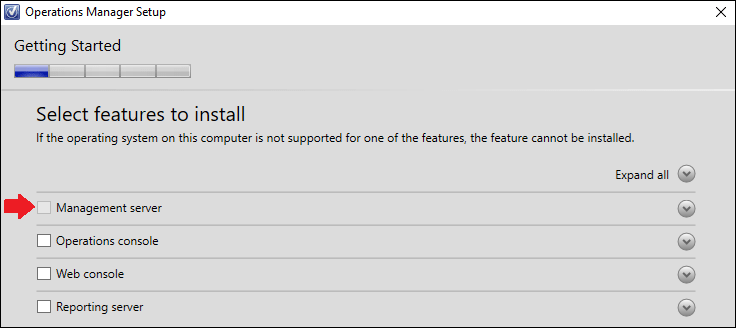
(A gray check box indicates that the feature is installed)
Note: The installation status can also be checked in the SCOM installation log: OpsMgrSetupWizard.log which is found at: %LocalAppData%\SCOM\LOGS
If the installation completed successfully, the end of the OpsMgrSetupWizard.log log file should show a similar result to this:
Installing the Operations Console
Prerequisites:
Command-Line Reference:
setup.exe /silent /install /components:OMConsole
/EnableErrorReporting:[Never|Queued|Always]
/SendCEIPReports:[0|1]
/UseMicrosoftUpdate:[0|1]
/AcceptEndUserLicenseAgreement:1
(Make sure that everything is one line when you run the full command!)
1. Open up a Command Prompt (Admin).
2. By default the Operations Console will be installed in "C:\Program Files\":
If we want to install the Operations Console to another location, add the /InstallPath parameter:
setup.exe /silent /install /installpath:"D:\Program Files" /components:OMConsole
3. We will now need to add whether we want to enable error reporting or not, select one of the following values:
/EnableErrorReporting:Never
(Do not opt in to sending automatic error reports)
/EnableErrorReporting:Queued
(Opt in to sending error reports, but queue the reports for review before sending)
/EnableErrorReporting:Always
(Opt in to automatically send error reports)
4. Next we will need to select whether we want to opt in the Customer Experience Improvement Program (CEIP) or not, select one of the following values:
/SendCEIPReports:0
(Do not opt in)
/SendCEIPReports:1
(Opt in)
5. Now we’ll need to choose if we want to opt in Microsoft updates or not, select one of the following values:
/UseMicrosoftUpdate:0
(Do not opt in)
/UseMicrosoftUpdate:1
(Opt in)
6. Finally we need to agree to the end user licensing terms:
/AcceptEndUserLicenseAgreement:1
7. Before running the command let’s check which SCOM features we have installed:
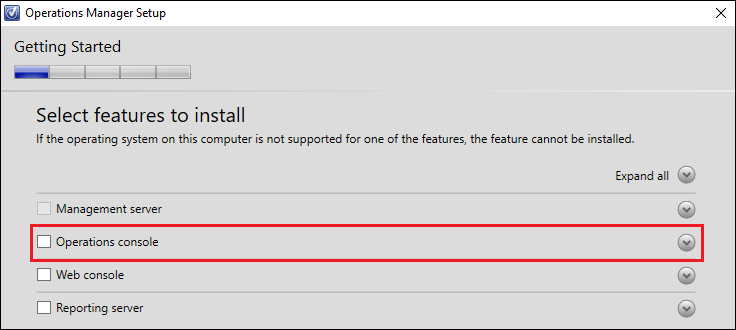
(A white check box indicates that the feature is not installed)
8. Now run the command from the administrative Command Prompt:
setup.exe /silent /install /components:OMConsole /EnableErrorReporting:Never /SendCEIPReports:0 /UseMicrosoftUpdate:0 /AcceptEndUserLicenseAgreement:1
9. After a few minutes the Operations Console feature should be installed.
10. Let’s finally verify that the SCOM Operations Console has been installed:
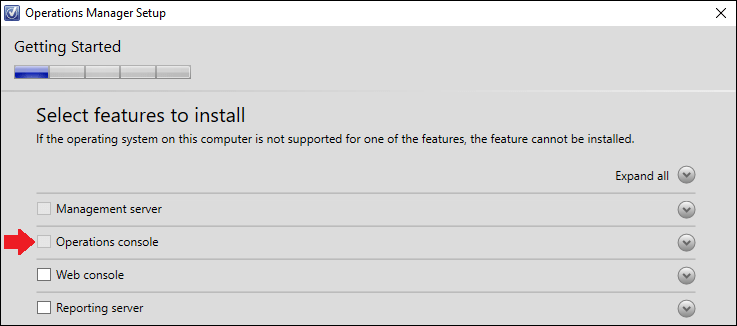
(A gray check box indicates that the feature is installed)
Note: The installation status can also be checked in the SCOM installation log: OpsMgrSetupWizard.log which is found at: %LocalAppData%\SCOM\LOGS
If the installation completed successfully, the end of the OpsMgrSetupWizard.log log file should show a similar result to this:
Installing the Operations Manager Web Console
Prerequisites:
- Internet Explorer version 11.
- Microsoft Edge version 40 and later.
- Google Chrome version 67 and later.
- Internet Information Services: IIS 7.5 and later versions with the IIS Management Console and the following role services installed:
- Static Content.
- Default Document.
- Directory Browsing.
- HTTP Errors.
- HTTP Logging.
- Request Monitor.
- Request Filtering.
- Static Content Compression.
- Web Server (IIS) Support.
- IIS 6 Metabase Compatibility.
- ASP.NET (both the 3.5 and 4.5 or higher versions of ASP.NET are required.)
- Windows Authentication.
- Selected website for web console: Requires a configured http or https binding.
- .NET Framework 4 or .NET Framework 4.5 is required.
Command-Line Reference:
setup.exe /silent /install /components:OMWebConsole
/ManagementServer:
/WebSiteName:"" [/WebConsoleUseSSL]
/WebConsoleAuthorizationMode:[Mixed|Network]
/SendCEIPReports:[0|1]
/UseMicrosoftUpdate:[0|1]
/AcceptEndUserLicenseAgreement:1
**(Make sure that everything is one one line when you run the full command!)
**
1. Open up a Command Prompt (Admin).
2. By default the Operations Manager Web Console will be installed in "C:\Program Files\":
If we want to install the Operations Manager Web Console to another location, add the /InstallPath parameter:
setup.exe /silent /install /installpath:"D:\Program Files" /components:OMWebConsole
3. Select whether to opt in for error reporting or not, select one of the following values:
/EnableErrorReporting:Never
(Do not opt in to sending automatic error reports)
/EnableErrorReporting:Queued
(Opt in to sending error reports, but queue the reports for review before sending)
/EnableErrorReporting:Always
(Opt in to automatically send error reports)
4. Select whether to opt in the Customer Experience Improvement Program (CEIP) or not, select one of the following values:
/SendCEIPReports:0
(Do not opt in)
/SendCEIPReports:1
(Opt in)
5. Select whether to opt in Microsoft updates or not, select one of the following values:
/UseMicrosoftUpdate:0
(Do not opt in)
/UseMicrosoftUpdate:1
(Opt in)
6. Finally select to agree to the end user licensing terms:
/AcceptEndUserLicenseAgreement:1
7. Before running the command let’s check which SCOM features we have installed:
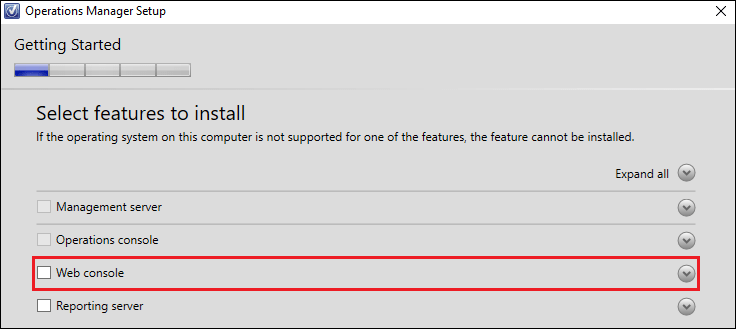
(A grayed out check box indicates that the feature is installed, the white check box means the feature is not installed)
8. Now run the command from the administrative Command Prompt:
setup.exe /silent /install /components:OMWebConsole /ManagementServer:SCOM.lab.ad /WebSiteName:"Default Web Site" /WebConsoleAuthorizationMode:Mixed /SendCEIPReports:0 /UseMicrosoftUpdate:0 /AcceptEndUserLicenseAgreement:1
9. After a few minutes the SCOM Web Console feature should be installed.
10. Let’s finally verify that the SCOM Web Console has been installed:
Note: The installation status can also be checked in the SCOM installation log: OpsMgrSetupWizard.log which is found at: %LocalAppData%\SCOM\LOGS
If the installation completed successfully, the end of the OpsMgrSetupWizard.log log file should show a similar result to this:
Installing the Operations Manager Reporting
Prerequisites:
- SCOM Management Server
Command-Line Reference:
setup.exe /silent /install /components:OMReporting
/ManagementServer:
/SRSInstance:<server\instance>
/DataReaderUser:<domain\username>
/DataReaderPassword:
/SendODRReports:[0|1]
/UseMicrosoftUpdate:[0|1]
/AcceptEndUserLicenseAgreement:1
(Make sure that everything is one one line when you run the full command!)
Note: The /ManagementServer parameter is only required when you are installing reporting on a server that is not a management server.
1. Open up a Command Prompt (Admin).
2. By default the SCOM Reporting will be installed in "C:\Program Files\":
If we want to install the SCOM Reporting to another location, add the /InstallPath parameter:
setup.exe /silent /install /installpath:"D:\Program Files" /components:OMReporting
3. Next we need to enter the server name and the instance name of the SQL Reporting Services>
/SRSInstance:<server\instance>
4. Now we’ll need to provide the credentials for the domain user that is used for the data reader account for the Reporting Services.
/DataReaderUser:<domain\username>
/DataReaderPassword: <password>
5. Select whether we want to send diagnostics and usage data or not, select one of the following values:
/SendODRReports:0
(Do not send data to Microsoft)
/SendODRReports:1
(Send data to Microsoft)
6. Select whether to opt in Microsoft updates or not, select one of the following values:
/UseMicrosoftUpdate:0
(Do not opt in)
/UseMicrosoftUpdate:1
(Opt in)
7. Finally select to agree to the end user licensing terms:
/AcceptEndUserLicenseAgreement:1
8. Before running the command let’s check which SCOM features we have installed:
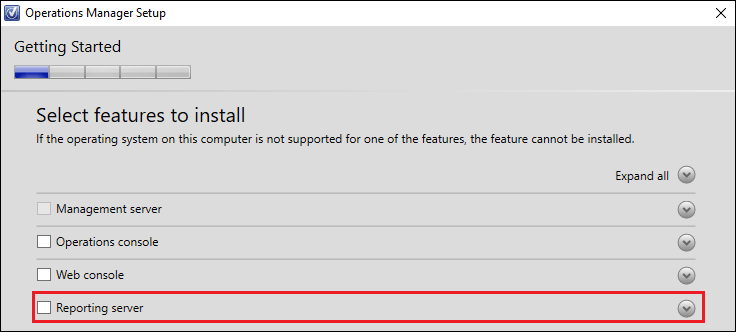
(A grayed out check box indicates that the feature is installed, the white check box means the feature is not installed)
9. Now run the command from the administrative Command Prompt:
setup.exe /silent /install /components:OMReporting /ManagementServer:SCOM.lab.ad /SRSInstance:SCOM\SCOMDB /DataReaderUser:LAB\svc-SCOM-DataReader /DataReaderPassword:"*********" /SendODRReports:0 /UseMicrosoftUpdate:0 /AcceptEndUserLicenseAgreement:1
10. After a few minutes the SCOM Reporting feature should be installed.
11. Let’s finally verify that the SCOM Web Console has been installed:
Note: The installation status can also be checked in the SCOM installation log: OpsMgrSetupWizard.log which is found at: %LocalAppData%\SCOM\LOGS
If the installation completed successfully, the end of the OpsMgrSetupWizard.log log file should show a similar result to this:
